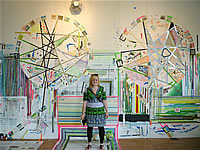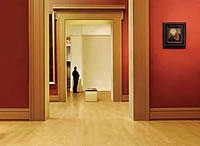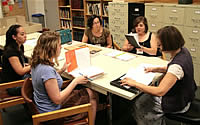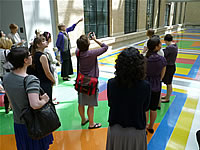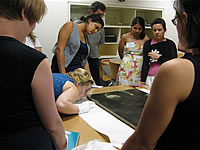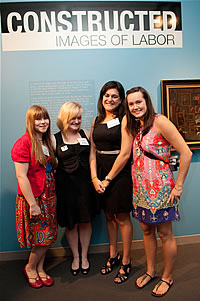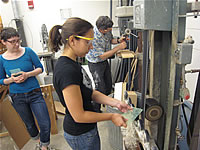Classes | Exhibition in the Museum | Individual Development | Travel
SIAMS was founded to provide students the opportunity to experience and understand the philosophical and intellectual context of art museums in a practical way. The six-week SIAMS curriculum clusters into four parts: academic classes, reading, writing; the exhibition practicum; travel; and opportunities for individual development.
Classes
Class time provides students with the opportunity to study and debate issues in the history and current practice of museums. With reading and writing assignments, the development of the SIAMS exhibition, and museum visits as jumping off points, the class covers a wide range of topics, providing students with a more nuanced understanding of what is at stake in the museum field. There are two principal instructors, two teaching assistants, and several guest lecturers. Sessions take place five days a week, with occasional evening offerings as well.
Classes meet in the Brown Fine Arts Center at Smith College, a state-of-the-art facility recently renovated and expanded. SIAMS students have the use of Smith’s libraries, image collections, technological resources, and other facilities.
Exhibition in the Museum
An exhibition practicum at the Smith College Museum of Art lies at the heart of the SIAMS program. Working closely with museum staff mentors, and together in small teams, students conduct research on works from the collection, then plan and mount an exhibition in one of the museum’s galleries. They write and publish scholarly catalogue entries, didactic materials for a general audience, and marketing materials designed to draw visitors in—very different modes of conveying information about art. They design education programs, the layout of the exhibition, and install the works of art themselves. In addition, they plan, advertise, and host the exhibition opening.
Annual SIAMS student organized exhibitions:
- Surface Tension: Reconsidering Water as a Subject, 2011
- Constructed: Images of Labor, 2010
- Between Pasture and Pavement: Diverging Visions at the Turn of the 20th Century, 2009
- Bare Identities: Looking Beyond the Human Form, 2008
- The World is Still Flat: Landscapes on Paper, 2007
- Face to Face: Looking at Portraiture, 2006
The Smith College Museum of Art is widely recognized as one of the leading college museums in the country. Its collection of nearly 25,000 works spans several millennia and many continents. The museum is particularly noted for its strong holdings of European and American art of the 19th and 20th centuries and for the depth and quality of its collections of prints, drawings, and photographs. Its professional staff is committed to undergraduate education; students will be introduced to all aspects of their work.
Individual Development
SIAMS provides participants a variety of opportunities to explore paths to the future which fit with their personal goals. Individuals spend two Career Exploration Days in different area museums working with particular staff members, and participate in a career counseling workshop organized by the Smith College Career Counseling Office. Skill-building in writing, speaking, and organizational work are built into the curriculum. Two graduate school training panels, representing at least eight different programs, are popular participant resources. Individual faculty appointments supplement the constant informal back-and-forth discussions during the program. The SIAMS graduate teaching assistants have been favorite and valued advisers for participants.
Travel
By visiting many different kinds of art museums and meeting with members of their professional staffs, participants get a behind-the-scenes look at the operation and mission of a range of institutions. Northampton is well positioned for an easy day trip to museums in Williamstown, Worcester, Hartford or New Haven. A multi-day trip to New York City and a two-day trip to the Boston area will include visits to an auction house, art galleries, private collection and an art conservation laboratory, to help students understand how museums build and care for their collections.
The institutions to be visited, and the individuals to be consulted, are chosen as the time for the program draws closer; selections are made on the basis of interesting current issues and developments. The list varies from year to year, but in general at least two museums of each type are included. Some possible candidates for visits are listed below.
- College and university museums (RISD, Yale, Smith, Williams)
- Encyclopedic urban museums (Museum of Fine Arts, Boston; Metropolitan Museum of Art; Brooklyn Museum; Worcester Art Museum; Wadsworth Atheneum)
- Museums founded on private collections (Gardner, Frick, Clark Art Institute)
- Culturally-specific museums (Whitney, Asia Society Gallery, Rubin Museum, El Museo del Barrio)
- Community museums (Fitchburg)
- Contemporary art museums/kunsthallen (MASS MoCA, Storm King,
PS1, DeCordova, ICA Boston)
At each site, the class meets with a member of the professional staff, who introduces them to the particular issues with which he or she is presently concerned. For example, an exhibition designer might take students through an exhibition in preparation; someone supervising a museum expansion project might walk them through the architectural planning process and/or the site itself; an operations director might discuss crowd-control issues around a blockbuster show; a curator might explain the process of making a particular acquisition or deciding how to present the permanent collection; a conservator might show students the inner workings of a lab; a director might talk about handling a controversy, modifying governance structures, or devising a long-range plan; a marketing director might explain a new campaign or image make-over; an editor might take the class through the stages of producing a catalogue.
Back at Smith, oral reports and class discussion allow students to incorporate their reflections on the experience into their class work and exhibition.
Travel is by Smith College van. Overnight accommodations are provided in New York and Boston.
SIAMS Home
Program Details
Career Exploration
Inside SIAMS
2011 Schedule
Summer Faculty
Program Cost
Application Forms
Location
E-mail siams@smith.edu to request a brochure or to ask a question
